Holiday Gifts for the Gardener
Posted on Tuesday, November 29, 2022 · Leave a Comment
First on my list for holiday gifts for the gardener is this: a subscription to this newspaper. Our local papers need subscribers in order to deliver to you the news you want but cannot get on-line. Yes, local news, gardening tips that fit your climate, obituaries and more. If your loved ones do not have subscriptions, think about giving one.
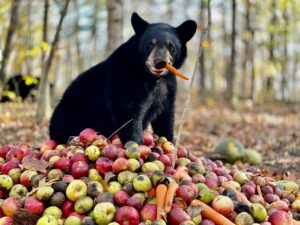
Consider a donation to a good non-profit like the Kilham Bear Center (photo by KBC)
Next, since most of us really need very little, think about a donation to a non-profit in your loved one’s honor. One of my favorites is a non-profit that for decades has nurtured orphan bear cubs, the Kilham Bear Center in Lyme, NH. The Center this year is nurturing and caring for more than 100 baby bears whose mothers have been killed by cars or hunters, and that would otherwise not survive. The Center has over 19 acres of fenced forest for the bears, and serves Vermont, New Hampshire and Massachusetts.
You can donate to The Kilham Bear Center at PO Box 37 Lyme, NH 03768 or go on-line to
https://kilhambearcenter.org/. On-line there are photos and videos of the bears. Visiting is not possible, as they want the bears to have as little contact with humans as possible because their goal is to return all to the wild where they avoid humans.
Other non-profits I like include The Native Plant Trust, the Audubon Society and the Nature Conservancy. As a supporter I get the Nature Conservancy magazine and I never cease to be amazed at all the good projects they initiate or support. And of course most states have nice non-profits supporting public gardens and wildlife areas that need our support.
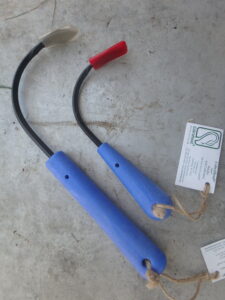
Cobra Head weeders now come in two sizes
Along with new products I like, each year I have to mention a few old favorites. The Cobra Head Weeder is a simple, well-made tool that virtually all gardeners love once they’ve tried it. Shaped like a curved steel finger, it will get under weeds or flowers to lift them from the earth. I use it for planting as well as weeding. Found at most garden centers or on-line at www.cobrahead.com for about $30. They now have a version for smaller hands and a long-handled weeder as well.
Books are a great present. I usually mention author Michael Dirr, my favorite expert on trees and shrubs. All his books are well researched, complete, and opinionated. My favorite is his classic, the “Manual of Woody Landscape Plants: their Identification, Ornamental Characteristics, Culture, Propagation and Uses”.
Another classic is Barbara Damrosch’s “The Garden Primer”. This book is a good reference on almost anything a gardener would wish to know. And at under $20 in paperback, it is great value for an 800-page book. More reliable than many of the on-line experts, I dare say.
Lastly a pair of books that work well together. First, Doug Tallamy’s “Nature’s Best Hope: A New Approach to Conservation That Starts in Your Yard”. This explains in readable, layman’s terms why what we select for our gardens impacts birds and pollinators.
A good companion to Tallamy’s books is “Essential Native Trees and Shrubs for the Eastern United States” by Tony Dove and Ginger Woolridge. This book supplies all you need to know for selecting the right trees and shrubs for your land to support wildlife.
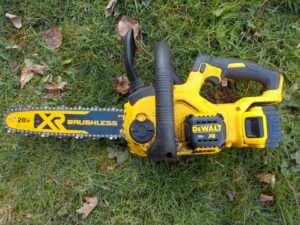
An electric chain saw can be useful for small project
But on to other needs of gardeners. Consider a small electric chain saw. They are safer, quieter, and easier to start and to use than gas powered ones. I have a DeWalt DCCS620 chain saw that has a 20-volt battery, 12-inch bar and weighs just 9 pounds. Great for cutting up downed branches, removing small trees and more. Available locally at $250 or less.
For gardeners who start seeds indoors each spring, there is an alternative to all those flimsy plastic 6-packs. You can buy a metal soil blocker that you can use to make small cubes of a soil mix for your seeds. Available from Johnny’s Seeds or Gardeners Supply, about $40.

With this simple tool, you can make Soil blocks for starting seedlings
Another great product for starting seedlings are electric heat mats. These sit under flats of seeds planted indoors, providing heat that speeds up the germination process. They are available in two sizes – enough for one flat or a big one for four or more flats. Great for things that take a long time to germinate.
For stocking stuffers I like seed packets. Give your loved ones seeds of less common vegetables and flowers that they might not find at the plant nursery. Garden gloves are great gifts, we all use them in spring and fall, and some people use them all summer, too.
Lastly, my wife, Cindy, swears by a natural bug repellent made in New Hampshire, White Mountain Deet-Free Insect Repellent (
http://www.whitemountaininsectrepellent.com). It doesn’t take much of this stuff to keep away black flies, she says. It comes in a 4-ounce bottle of all-natural ingredients (no fillers) for $15 plus shipping. Great stocking stuffer.
Use your imagination. There are so many nice things a gardeners will appreciate, including your own time promised for weeding in the spring!
Henry is a garden consultant, public speaker and the author of 4 gardening books. Reach him by e-mail at
henry.homeyer@comcast.net or PO Box 364, Cornish Flat, NH 03746.
Holiday Gifts for the Gardener
Posted on Tuesday, November 23, 2021 · Leave a Comment
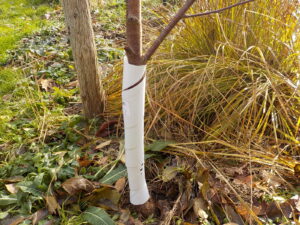
This tree guard keeps voles from damaging young trees
Ready to shop! Every time I turn on the radio or open a newspaper, there are articles about supply chain issues. Even the reliable old US Postal Service is saying deliveries may well be delayed. So share some garden produce this year or shop at a local, family-owned business when you can.
Food is a great gift. You don’t need fancy fruit shipped from Oregon if you made plenty of tomato sauce or quince jelly this year. Share the harvest. A quart of dried cherry tomatoes contains a lot of love and work. You had to grow, harvest, wash and dehydrate. Only people dear to my heart will rate such a gift.
My dream gift? A friend, loved one or reader sending me a nice card, along with a homemade certificate for four hours of weeding in my garden. Or two hours. Working in the garden with a friend or relative can be a great way to strengthen a friendship. Politics don’t matter in the garden. I might suspect my brother-in-law didn’t vote the way I did in the last election. But if he will bring his chain saw and help me take down and cut up a 12-inch diameter boxelder I want removed, send me the gift certificate!
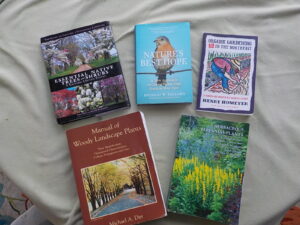
Gardening books make great presents
Books are great gifts, and books printed in the United States should be readily available at your local bookstore. My first choice for a book to give? Doug Tallamy’s book, Nature’s Best Hope: A New Approach to Conservation That Starts in Your Yard. It explains how what we plant can affect the planet, especially our pollinators and birds. And all of us, really.
I’ve re-printed my last
gardening book, and will be selling it at a discount directly to you, signed. It’s a collection of my best
articles organized around the calendar year. It’s titled
Organic Gardening (not just) in the Northeast: A Hands-On, Month-by-Month Guide. Signed and mailed to you for just $19. Send a check to Henry Homeyer at PO Box 364, Cornish Flat, NH 03746. I will try to figure out how to reduce the price on my website,
www.Gardening-Guy.com where it is currently for sale at $21 if you want to use PayPal.
What else at the bookstore? Essential Native Trees and Shrubs for the Eastern United States by Tony Dove and Ginger Woolridge is a great companion for Doug Tallamy’s book. Michael Dirr has written lots of great tree books. He is informative and opinionated. Allan Armitage is just as opinionated and thorough about flowers as Dirr is about trees. Or get a gift certificate and let your gardener pick her own books at the local bookstore.
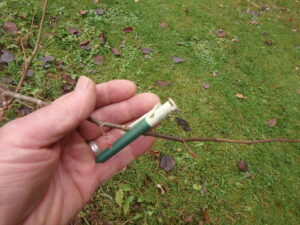
Garlic clips work well for me to deter deer
If deer are a problem in the garden of your loved one, I find nothing better than “Fend Off Deer and Rabbit Repellent Odor Clips”. Available at Gardeners Supply and other retailers. A package of 25 sells for about $20. I use one or two per shrub to keep deer away all winter. They clip on with a clothes-pin style attachment. They contain just garlic and soy oil, no chemicals.
I recently wrote about using hardware cloth (wire screening) to keep voles from chewing off bark and killing young trees. Since then I have used plastic spiral tree guards that are easy to install and will protect against sun scald in winter, too. They are inexpensive and can be re-used (I will remove them in the spring). They are sold as Rainbow Professional LTD White Spiral Tree Guards at OESCOinc.com or by calling them at 413-469-4335. They sent my order out the very day I called.
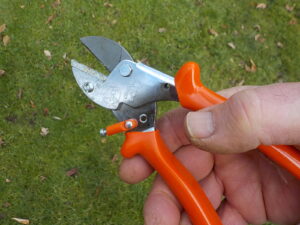
I like this Lowe anvil pruner
Also available from OESCO are some pruners that I like a lot. OESCO is a small company based in Conway MA catering to orchard professionals. The pruners are made by a German company, Lowe with 2 dots over the O, not to be confused with the American retailer Lowe’s. The pruners are of the anvil type, designed and manufactured well. They sell a size nice for small hands (Lowe 5.107) and a larger size, too. OESCO sells replacement blades and parts.
Of course every gardener needs a good weeding tool. My favorite is the CobraHead, and has been for years. They now have a mini-Cobrahead which is designed for smaller hands. Available from CobraHead.com or 866-962-6272 or at your local garden center. It has a single curved tine like a steel finger that will tease out roots from below while you tug a weed from above. I emailed the owner, Noel Valdes, who told me there are plenty in stock.
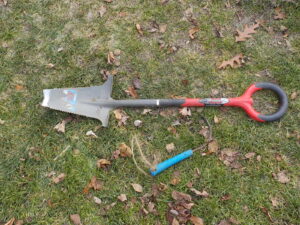
Root Slayer spade and CobraHead weeder are excellent tools
I found a wonderful shovel for digging in tough areas with lots of roots. It’s called the Root Slayer and is available from Gardeners Supply and a few other retailers. I’ve used mine all summer, and love it! Great for cutting though sod, too. It has a sharp blade and teeth along the sides for slicing roots.
Lastly, think about a gift certificate at your local nursery or garden center for plant purchases in the spring. Plants are always good.
Henry lives, writes and
gardens in Cornish Flat, NH. His e-mail is
henry.homeyer@comcast.net. He is the author of 4
gardening books.
How What We Grow Helps Our Feathered Friends – and the Environment
Posted on Tuesday, April 6, 2021 · Leave a Comment
By now birds are finding their own food and have less need for that sunflower seed we have been providing during the cold days of winter. So what can we do to help our birds as they go into the season of having young? Growing native trees and shrubs on our property can be a huge help to our bird friends.
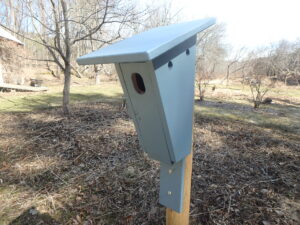
Bird houses are nice but we need to do more for our baby birds including growing native plants
Let me explain. It is not enough to put out birdhouses, we need to help birds find food for their chicks. The diet of baby birds is about 90% composed of caterpillars. Caterpillars – the larvae of Lepidoptera (moths and butterflies) – are high in fat and protein that developing birds need to grow and be healthy. One clutch of chickadees can, according to entomologist Doug Tallamy, a PhD researcher from the University of Delaware, consume 6,000 to 9,000 caterpillars in the 16 days from hatching to fledgling. And most parent birds continue to feed their chicks even after they have fledged.
In Tallamy’s new book, Nature’s Best Hope: A New Approach to Conservation That Starts in Your Yard, he explains that not all trees and shrubs are created equal. Those that evolved alongside the butterflies and moths are palatable to them. Those that were imported from Asia or Europe mostly are not of interest to them.
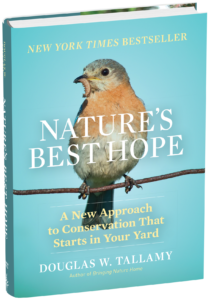
Nature’s Best Hope
Most woody plants create toxins or bad-tasting chemicals to keep all sorts of animals from eating them, but caterpillars have developed ways to eat most native tree leaves – they have adapted to eat what was available to them. It’s as if they learned to eat things, the way we learned to eat Brussels sprouts.
Although caterpillars eat the leaves of our native plants, they rarely damage or defoliate their host plants. Tent caterpillars and a few other imported species will defoliate trees, but that’s rare. It’s just that most of us never notice the little holes chewed in the leaves that are supporting the caterpillars.
In fact, I rarely notice caterpillars in the trees and shrubs at all – but our bird friends certainly do. They evolved along with the caterpillars and are genetically programmed to recognize them and bring them to their young, even birds that are seed eaters.
As Dr.Tallamy explains in the book, not all native plants are created equal. Some native species may only feed a few. Some, like our oaks, feed many hundreds of species of caterpillars. These “keystone species” are critical to supporting our wildlife. Five percent of the native species support over 70% of our Lepidoptera, according to Tallamy.
So what plants are best to feed the caterpillars that support our birds?
According to Tallamy’s research, native oaks, cherries, willows, birches, poplars and elms are best, and goldenrods, asters and perennial sunflowers “lead the herbaceous pack.” The National Wildlife Federation’s Plant Finder website (
https://www.nwf.org/NativePlantFinder) allows you to enter your zip code and see what plants are best for your zone, and how many pollinators are served by each.
Tallamy did a study in Portland, Oregon and found that of 1176 trees he identified on the streets there, 91.5% of them were from other continents or ecoregions, mainly Asia. What does that mean? Portland is a pretty city with lots of trees, but it is largely a wasteland for caterpillars that feed our baby birds. The birds need to nest where they can get food for their young.

Leaf litter and native plants are better under a tree than lawn
If you wish to improve your landscape and plant native species that will support wildlife, think about reducing lawn size. Tallamy explains that there are 40 million acres of lawn in America, an area the size of New England. Thirty percent of our water is used to water lawns, and 40 to 60% of all fertilizer ends up in our waterways and drinking water, he wrote.
Doug Tallamy proposes that we all join him in creating, a “Homegrown National Park”, by reducing our lawns by 50% and growing native plants. This will create wildlife corridors and improve our environment in many ways. The plants will sequester carbon in ways that lawn does not. It will help to save endangered species of insects and birds. It will reduce pollution of our air and water. Who could argue with such an idea?
According to one study, in newer housing developments lawn covers about 92% of space not covered with driveways and buildings. If we were all willing to reduce our lawns and add trees, shrubs and native perennials, that would make a big difference in helping to reduce species extinction of Lepidoptera, birds and small mammals. It does not require eliminating lawn, just reducing it. Think of lawn as area rugs, not wall-to-wall carpeting.
What else can you do to help our birds? Add a water feature. Even a small pool with a re-circulating pump will attract birds, especially migrating birds that need water and food for their long journey.
Instead of lawn, add native groundcovers. Lawns get compacted by lawnmowers, making it difficult for caterpillars and native bees to burrow in the ground. Most caterpillars pupate in the ground or in leaf litter, but lawns are not suitable. Other than honeybees, most bees burrow into the ground or into decaying wood to lay their eggs and hatch their young.
I love the idea of us all of linking our properties together to support our butterflies and bees. You can go to
www.homegrownnationalpark.org to register your property as part of this movement. Thanks!
Henry is the author of 4 gardening books and a UNH Master gardener. You may reach him at
henry.homeyer@comcast.net or PO Box 364, Cornish Flat, NH 03746.














